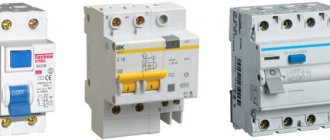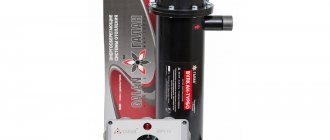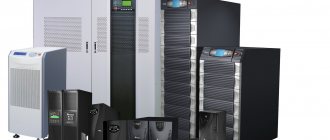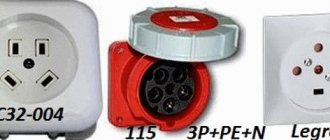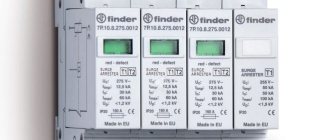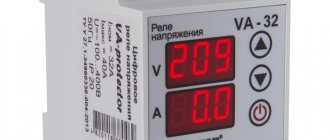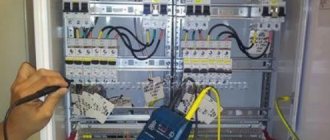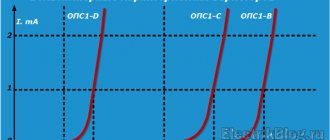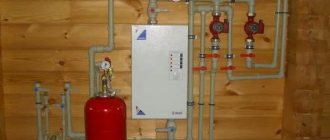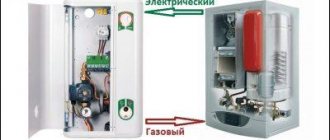Assembling an electrical panel for a private home with a voltage of 380 V and a power of up to 15 kW requires an appropriate approach and the presence of the following tools:
- pliers;
- flat and figured screwdrivers;
- crimping pliers;
- assembly knife with a set of replaceable blades.
All work begins with planning, and if the home owner prefers to contact an electrical company, then a project and preliminary diagram are drawn up before installation begins. You should also prepare the components of the shield and consumables (crimping lugs, heat shrink, DIN rail, dowels).
Which machine is suitable for 15 kW
The purpose of a 3-phase machine is protection against overcurrents and overloads. The 15 kW modification operates on a network with a voltage of 380 V, that is, you will need a 25 A device for input. When choosing, you need to take into account that in conditions of short circuits, the current strength increases and can cause a fire in the electrical wiring.
When selecting a 15 kW machine model for a three-phase load, you will need to take into account the parameters of the permissible voltage and current during a short circuit. It is worth focusing on the calculated current indicators of the cable with the minimum cross-section that protects the switch and the rated current of the receiver.
When calculating the input switching machine according to power parameters in a 380 V network, the following are taken into account:
- electrical power – actual and additional;
- cable loading intensity;
- availability of free capacity in the design indicator of a residential building;
- remoteness of outbuildings and non-residential premises from the cable entry point.
In a 15 kilowatt network with additional power, an ASU device is installed.
Did you come for a service, not information?
In deciding the question with a load of 15 kW how many amperes the machine should have, regulatory documents and special calculations prescribe 25A with three-phase power supply, i.e. 380V. Thus, if you place such a protection device at the power supply input and turn on the maximum load, then if the specified current strength of the circuit breaker is insufficient, the latter will trip and turn off. This means that the load is greater than 15 kW. In case of prolonged operation of the protection without shutting down, you can breathe easy and start the functioning of the room.
However, it is important to remember the following: such experiments can only be carried out with an unsealed input circuit breaker. If you are faced with a seal, then the questions about which machine to install at 15 kW, as well as for 15 kW 3 phase, how many amperes the machine is recommended to install, disappear. In this case, it is worth contacting a specialized organization that will help you understand the connection diagram, the capabilities of the existing circuit breaker, and also calculate the required electrical loads. Experts will tell you how to distribute the load evenly among the phases, what power is missing, and also which 15 kW 3-phase machine should be used in the distribution panel of this network.
Functions of three-phase machines
Before choosing an automatic switch, you should understand its functionality. Users are often mistaken into thinking that the device protects household appliances. The machine does not respond to its electrical indicators, only triggering in the event of a short circuit or overload. The three-phase functions include:
- simultaneous maintenance of several single-phase circuit zones;
- preventing the formation of overcurrents on the line;
- joint work with AC rectifiers;
- protection of high-power equipment;
- increased power due to the installation of a special converter;
- fast response in short circuit mode on a line with a large number of consumers;
- the ability to turn off manually using a switch or switch;
- Compatible with optional safety terminals.
Without a automatic device, the risk of cable fire increases.
Operating principle and purpose of the circuit breaker
The three-phase circuit breaker is activated in case of a line fault using an electromagnetic switch. The principle of operation of the element is to heat the bimetallic plate at the moment the current rating increases and the voltage is turned off.
The fuse prevents short circuits and overcurrents with values higher than the calculated values from affecting the wiring. Without it, the cable cores heat up to the melting point, which leads to the ignition of the insulating layer. For this reason, it is important to know whether the network can handle the voltage.
Correspondence of wires to load
The problem is typical for old buildings, in which new machines, a meter, and an RCD are installed on the existing line. The machines are selected according to the overall power of the equipment, but sometimes they do not work - the cable smokes or burns.
For example, the cores of an old cable with a cross-section of 1.5 mm2 have a current limit of 19 A. If equipment with a total current of 22.7 A is turned on at a time, only a 25 Ampere modification will provide protection.
The wires will heat up, but the switch will remain turned on until the insulation melts. A fire can be prevented by completely replacing the wiring with a copper cable with a cross-section of 2.5 mm2.
Protecting the weakest section of cable wiring
Based on clause 3.1.4 of the PUE, the task of the automatic device is to prevent overload on the weakest link of the electrical circuit. Its rated current is selected based on the current of the connected household appliances.
If the machine is selected incorrectly, the unprotected area will cause a fire.
Electric installation work
We will not dwell in more detail on the preparation of documentation for connecting the power supply; this is a separate topic. Our task is to determine the materials and devices for external installation work, which, although they are an intermediate stage in the connection, are the most important, since they are related to human safety.
Single-phase or three-phase input?
For both three-phase and single-phase networks, the permitted power is indicated in the technical specifications. This can be 15 kW for both options, that is, the benefit of a three-phase network is not in power, but in the possibility of using an input cable of a smaller cross-section and reducing the load, since the current is distributed over 3 phases. Therefore, in a three-phase network, the rating of the input circuit breaker will be lower.
But the input distribution board will be increased in size, since the meter itself is larger than a single-phase one, and the circuit breakers occupy 3-4 modules. Three-phase RCDs also have larger dimensions. This is a disadvantage of three-phase input into the house, but it is not very significant compared to such advantages as the ability to connect asynchronous electric drives, electric boilers, heaters, and electric stoves in the house.
To avoid phase imbalance from powerful electrical receivers, the electrician-installer must distribute the load as evenly as possible. The operating voltage of a three-phase network is 380V, therefore, in order to eliminate the risk of fire and electric shock, it would be a good idea to install a three-pole additional circuit breaker right before entering the house. This prevents short circuits at the input.
External connection and electrical panel
When connecting a private house to the power supply, an air input is most often used (which is also indicated in the technical specifications) with the installation of an electricity metering cabinet (SHUE) to eliminate cases of electricity theft and problems with the commercial registration of electricity supply.
According to the standards, the input cable must have a cross-section of at least 16 mm2 if the core is aluminum, and 10 mm2 if the core is copper, at a distance from the support pole of 25 m. For a distance of less than 25 m, the cross-section of the aluminum wire is 10 mm2, copper - 4 mm2 .
Principles for calculating the machine according to the cable cross-section
Calculations for a 3-phase automatic circuit breaker are carried out based on the cable cross-section. For a 25 A model, you will need to refer to the table.
| Wire cross-section, mm2 | Permissible load current based on cable material | |
| Copper | Aluminum | |
| 0,75 | 11 | 8 |
| 1 | 15 | 11 |
| 1,5 | 17 | 13 |
| 2,5 | 25 | 19 |
| 4 | 35 | 28 |
The 25 Ampere modification can be used to protect wiring or installed at the input.
For example, a copper wire with a cross-section of 1.5 mm2 with a permissible load current of 19 A is used for wiring. To prevent the cable from heating up, you will need to select a lower value - 16 A.
Selection of automatic switch by power
Calculating the total power of household appliances will help you select a protective switch. You will need to look at the value in the device passport. For example, in the kitchen the following are plugged into the socket:
- coffee maker – 1000 W;
- electric oven – 2000 W;
- microwave oven – 2000 W;
- electric kettle – 1000 W;
- refrigerator – 500 W.
Summing up the indicators, we get 6500 W or 6.5 kilowatts. Next, you will need to refer to the table of machines depending on the connection power.
| Single-phase connection 220 V | Three-phase connection | Machine power | |
| Delta circuit 380 V | Star circuit, 220 V | ||
| 3.5 kW | 18.2 kW | 10.6 kW | 16 A |
| 4.4 kW | 22.8 kW | 13.2 kW | 20 A |
| 5.5 kW | 28.5 kW | 16.5 kW | 25 A |
| 7 kW | 36.5 kW | 21.1 kW | 32 A |
| 8.8 kW | 45.6 kW | 26.4 kW | 40 A |
Based on the standard voltage wiring table, you can select a 32 A device that is suitable for a total power of 7 kW.
If you plan to connect additional equipment, an increase factor is used. The average value of 1.5 is multiplied by the power obtained from the calculations. A reduction factor is applied if it is impossible to operate several electrical appliances at the same time. It is equal to 1 or minus 1.
Selecting a machine depending on the load power
For apartments and houses with new electrical wiring, the choice of machine is made based on the calculated load current.
A three-phase type device can be calculated by the rated load current or by the response speed in conditions of exceeding the current value. For calculations, you need to add up the power of all consumers and calculate the current passing through the line. Work is performed according to the formula:
- P – total power of all household appliances;
- U – network voltage.
For example, the power is 7.2 kW, calculated using the formula 7200/220 = 32.72 A. The table shows ratings of 16, 20, 32, 25 and 40 A. The value is 32.72 A, taking into account the operation of the device at a value of 1 ,13 times more than the nominal value, multiply: 32x1.13=36.1 A. The table shows that it is better to install a 40 A model.
Criteria for selecting a three-phase switch
Before purchasing, it is worth considering all the parameters that the input device will have.
Phase and voltage
Single-phase 220 V models are connected to one terminal, three-phase 380 V models are connected to three.
Leakage current
The body is marked with the Greek letter “delta”. The current leakage of a private house is about 350 mA, of a separate group of devices - 30 mA, lamps and sockets - 30 mA, single links - 15 mA, boiler - 10 mA.
Varieties by current
The machine has indexes A (triggered by DC leakage) and AC (triggered by AC leakage).
Number of poles
Depending on the number of poles, you can purchase a three-phase switch:
- single-pole type of devices for protecting one cable and one phase;
- two-pole, represented by two devices with a common switch - switching off occurs when the permissible value of one of them is exceeded, at the same time the neutral and phase in a single-phase network are cut off;
- a three-pole device that provides interruption and protection of the phase circuit - they are three devices with a common activation/deactivation handle;
- a four-pole device, which is mounted only on the input of a three-phase switchgear, breaks all three phases and the working zero. Breaking the grounding of the protection is unacceptable.
Regardless of the number of poles, the device shutdown time should not exceed 0.3 seconds.
Installation location
For domestic use, a 3-phase electric circuit breaker marked C is intended for 25 A. In this case, it is better to install products C50, C65, C85, C95 at the input. For sockets or other points - C 25 and C 15, for lighting - C 12 or C 17, for an electric stove - C 40. They will operate when the current readings are 5-10 times higher than the nominal value.
Methods for selecting a difavtomat
For example, consider a kitchen where a large amount of equipment is connected. First, you need to set the total power rating for a room with a refrigerator (500 W), microwave (1000 W), kettle (1500 W) and hood (100 W). The total power indicator is 3.1 kW. Based on it, various methods are used to select a 3-phase machine.
Table method
Based on the device table, a single-phase or three-phase device is selected based on the connection power. But the value in the calculations may not coincide with the tabular data. For a 3.1 kW network section, you will need a 16 A model - the closest value is 3.5 kW.
Graphical method
The selection technology is no different from the tabular one - you will need to find a schedule on the Internet. In the figure, the switches with their current load are shown horizontally, and the power consumption in one section of the circuit is shown vertically.
To establish the power of the device, you will need to draw a line horizontally to the point with the rated current. A total network load of 3.1 kW corresponds to a 16 A switch.
Nuances to consider
No one can know exactly what household appliances will be in a house or apartment. For this reason you should:
- increase the total calculated power of a three-phase automatic circuit breaker by 50%, or apply an increase factor of 1.5;
- a reduction factor is taken into account when there are not enough sockets in the room to simultaneously connect equipment;
- to simplify calculations, the load should be divided into groups;
- powerful devices should be connected separately, taking into account the low-power load;
- to calculate a low-power load, you will need to divide the power by the voltage;
- wiring is the main factor that is taken into account when choosing a 3-phase automatic switch; old aluminum wires can withstand 10 A, but if taken for 16 A sockets, they can melt;
- in domestic conditions, models with current ratings of 6, 16, 25, 32 and 40 A are most often used.
When purchasing a three-phase differential circuit breaker, you need to take into account that the main markings are on the case or in the passport. Using formulas and tables will help you choose a model in accordance with the wiring in the apartment and the power of household appliances.
Long gone are the days of ceramic plugs that were screwed into home electrical panels. Currently, various types of circuit breakers that perform protective functions are widely used. These devices are very effective against short circuits and overloads. Many consumers have not yet fully mastered these devices, so the question often arises which machine should be installed at 15 kW. The reliable and durable operation of electrical networks, appliances and equipment in a house or apartment completely depends on the choice of machine.
Some useful tips for assembling a shield
When assembling an electrical panel, it is necessary to use only high-quality and reliable electrical products. You should not pay attention to cheaper Chinese analogues; personal safety is much more important.
To connect wires to machines, it is best to use special lugs for crimping. Of course, then you will have to purchase pliers with which crimping is performed, but their cost is not too high.
The use of insulating tape is no longer relevant; many electricians use exclusively heat-shrinkable tubing. This consumable is convenient and reliable, and it is not necessary to purchase a hair dryer; you can use an ordinary lighter.
For ease of use, all elements of the electrical cabinet must be marked. Only then will it be possible to quickly and easily turn off the voltage in a certain room. You can make notes on the body of the device or make small signs and attach them to the product with tape.
Basic functions of machines
Before choosing an automatic protective device, you need to understand the principles of its operation and capabilities. Many people consider the main function of the machine to be the protection of household appliances. However, this judgment is absolutely wrong. The machine does not react in any way to devices connected to the network; it is triggered only during short circuits or overloads. These critical conditions lead to a sharp increase in current strength, causing overheating and even fire of cables.
A special increase in current strength is observed during a short circuit. At this moment, its value increases to several thousand amperes and the cables are simply not able to withstand such a load, especially if its cross-section is 2.5 mm2. With such a cross-section, an instant fire occurs in the wire.
Therefore, a lot depends on the correct choice of machine. Accurate calculations, including power calculations, make it possible to reliably protect the electrical network.
Transfer rules
Often, when studying the instructions included with some devices, you can see the power designation in volt-amperes. Experts know the difference between watts (W) and volt-amperes (VA), but practically these quantities mean the same thing, so there is no need to convert anything here. But kW/hour and kilowatts are different concepts and should not be confused under any circumstances.
To demonstrate how to express electrical power in terms of current, you need to use the following tools:
- tester;
- current clamps;
- electrical reference book;
- calculator.
When converting amperes to kW, use the following algorithm:
- Take a voltage tester and measure the voltage in the electrical circuit.
- Using current measuring keys, measure the current strength.
- Recalculation is carried out using the formula for direct voltage in the network or alternating.
As a result, the power is obtained in watts. To convert them into kilowatts, divide the result by 1000.
We also have material on our website about the rules for converting Amperes to Watts. To view it, please follow the following link.
Single phase electrical circuit
Most household appliances are designed for a single-phase circuit (220 V). The load here is measured in kilowatts, and the AB marking contains amperes.
Machine calculation parameters
Each circuit breaker primarily protects the wiring connected downstream of it. Basic calculations of these devices are carried out based on the rated load current. Power calculations are carried out in the case when the entire length of the wire is designed to carry the load, in accordance with the rated current.
The final choice of rated current for the machine depends on the cross-section of the wire. Only after this can the load value be calculated. The maximum current allowed for a wire with a certain cross-section must be greater than the rated current indicated on the machine. Thus, when choosing a protective device, the minimum wire cross-section present in the electrical network is used.
When consumers have a question about which machine should be installed at 15 kW, the table also takes into account the three-phase electrical network. There is a methodology for such calculations. In these cases, the rated power of a three-phase circuit breaker is determined as the sum of the powers of all electrical appliances planned to be connected through the circuit breaker.
Reasons for making a transfer
Power and current are key characteristics necessary for the proper selection of protective devices for equipment powered by electricity. Protection is needed to prevent melting of the wiring insulation and breakdown of units.
Electrical wiring supplying lighting, an electric stove, and a coffee machine must be protected by individually selected devices. After all, each consumer creates “its own” load - in other words, consumes a certain current.
By the way, the cables and wires that supply the listed household devices have a certain current-carrying capacity. The latter is dictated by the cross-section of the cores.
Each protective device must operate at the moment of a voltage surge that is dangerous for the type of equipment being protected or a group of technical devices. This means that RCDs and machines should be selected so that during a threat to a low-power device, the network is not completely disconnected, but only the branch for which this surge is critical.
The housings of the circuit breakers offered by the retail chain are marked with a number indicating the maximum permissible current. Naturally, it is indicated in Amperes.
But on the electrical appliances that are required to protect these machines, the power they consume is indicated. This is where the need for translation arises. Despite the fact that the units we are examining belong to different current characteristics, the connection between them is direct and quite close.
Voltage is the potential difference, in other words, the work put into moving a charge from one point to another. It is expressed in Volts. Potential is the energy at each point where the charge is/was.
Current strength refers to the number of Amperes passing through a conductor in a specific unit of time. The essence of power is to reflect the speed at which the charge moved.
Power is indicated in Watts and Kilowatts. It is clear that the second option is used when an overly impressive four- or five-digit figure needs to be reduced for ease of perception. To do this, its value is simply divided by a thousand, and the remainder is rounded up as usual.
Powering high-power equipment requires a higher rate of energy flow. The maximum permissible voltage for it is higher than for low-power equipment. The machines selected for it should have a higher operating limit. Therefore, accurate selection according to the load with competent conversion of units is simply necessary.
Basic functions of machines
Before choosing an automatic protective device, you need to understand the principles of its operation and capabilities. Many people consider the main function of the machine to be the protection of household appliances. However, this judgment is absolutely wrong. The machine does not react in any way to devices connected to the network; it is triggered only during short circuits or overloads. These critical conditions lead to a sharp increase in current strength, causing overheating and even fire of cables.
A special increase in current strength is observed during a short circuit. At this moment, its value increases to several thousand amperes and the cables are simply not able to withstand such a load, especially if its cross-section is 2.5 mm2. With such a cross-section, an instant fire occurs in the wire.
Therefore, a lot depends on the correct choice of machine. Accurate calculations, including power calculations, make it possible to reliably protect the electrical network.
What is the danger of a cable mismatch with the network load?
Selecting the correct power circuit breaker is a very important task. An incorrectly selected device will not protect the line from a sudden increase in current.
But it is equally important to choose the correct cross-section of the electrical cable. Otherwise, if the total power exceeds the rated value that the conductor can withstand, this will lead to a significant increase in the temperature of the latter. As a result, the insulating layer will begin to melt, which can lead to a fire.
To more clearly imagine the consequences of a mismatch between the wiring cross-section and the total power of the devices connected to the network, let’s consider this example.
New owners, having bought an apartment in an old house, install several modern household appliances in it, giving a total load on the circuit equal to 5 kW. The current equivalent in this case will be about 23 A. In accordance with this, a 25 A circuit breaker is included in the circuit. It would seem that the choice of the circuit breaker in terms of power was made correctly, and the network is ready for operation. But some time after turning on the appliances, smoke appears in the house with a characteristic smell of burnt insulation, and after a while a flame appears. The circuit breaker will not disconnect the network from the power supply - after all, the current rating does not exceed the permissible one.
If the owner is not nearby at this moment, the melted insulation will cause a short circuit after some time, which will finally trigger the machine, but the flames from the wiring may already spread throughout the house.
The reason is that although the power calculation of the machine was done correctly, the wiring cable with a cross-section of 1.5 mm² was designed for 19 A and could not withstand the existing load.
So that you do not have to take out a calculator and independently calculate the cross-section of electrical wiring using formulas, we present a standard table in which it is easy to find the desired value.
Machine calculation parameters
Each circuit breaker primarily protects the wiring connected downstream of it. Basic calculations of these devices are carried out based on the rated load current. Power calculations are carried out in the case when the entire length of the wire is designed to carry the load, in accordance with the rated current.
The final choice of rated current for the machine depends on the cross-section of the wire. Only after this can the load value be calculated. The maximum current allowed for a wire with a certain cross-section must be greater than the rated current indicated on the machine. Thus, when choosing a protective device, the minimum wire cross-section present in the electrical network is used.
When consumers have a question about which machine should be installed at 15 kW, the table also takes into account the three-phase electrical network. There is a methodology for such calculations. In these cases, the rated power of a three-phase circuit breaker is determined as the sum of the powers of all electrical appliances planned to be connected through the circuit breaker.
For example, if the load of each of the three phases is 5 kW, then the operating current is determined by multiplying the sum of the powers of all phases by a factor of 1.52. Thus, it turns out 5x3x1.52 = 22.8 amperes. The rated current of the machine must exceed the operating current. In this regard, the most suitable protective device would be rated 25 A. The most common ratings of circuit breakers are 6, 10, 16, 20, 25, 32, 40, 50, 63, 80 and 100 amperes. At the same time, the compliance of the cable cores with the declared loads is clarified.
This technique can be used only in cases where the load is the same on all three phases. If one of the phases consumes more power than all the others, then the rating of the circuit breaker is calculated based on the power of this particular phase. In this case, only the maximum power value is used, multiplied by a factor of 4.55. These calculations allow you to select a machine not only according to the table, but also according to the most accurate data obtained.
How many Watts are in 1 Ampere and amperes in a cotton wool?
To convert Watts to Amps at alternating or direct voltage you will need the formula:
I = P/U, where
I is the current strength in amperes; P – power in watts; U – voltage in volts, if the network is three-phase , then I = P/(√3xU), since it is necessary to take into account the voltage in each of the phases.
The root of three is approximately equal to 1.73.
That is,
in one watt there is 4.5 mAm (1A = 1000 mAm) at a voltage of 220 volts and 0.083 Am at 12 volts .
When it is necessary to convert current into power (find out how many watts are in 1 ampere), then use the formula:
P = I * U or P = √3 * I * U, if calculations are carried out in a 3-phase 380 V network.
This means that if we are dealing with a 12-volt automotive network, then 1 ampere is 12 Watts, and in a 220 V household electrical network, this current strength will be in an electrical appliance with a power of 220 W (0.22 kW). In industrial equipment powered by 380 Volts, as much as 657 Watts.
Ampere – Watt conversion table:
| 6 | 12 | 24 | 220 | 380 | Volt | |
| 5 Watt | 0,83 | 0,42 | 0,21 | 0,02 | 0,008 | Ampere |
| 6 Watt | 1,00 | 0,5 | 0,25 | 0,03 | 0,009 | Ampere |
| 7 Watt | 1,17 | 0,58 | 0,29 | 0,03 | 0,01 | Ampere |
| 8 Watt | 1,33 | 0,67 | 0,33 | 0,04 | 0,01 | Ampere |
| 9 Watt | 1,5 | 0,75 | 0,38 | 0,04 | 0,01 | Ampere |
| 10 Watt | 1,67 | 0,83 | 0,42 | 0,05 | 0,015 | Ampere |
| 20 Watt | 3,33 | 1,67 | 0,83 | 0,09 | 0,03 | Ampere |
| 30 Watt | 5,00 | 2,5 | 1,25 | 0,14 | 0,045 | Ampere |
| 40 Watt | 6,67 | 3,33 | 1,67 | 0,13 | 0,06 | Ampere |
| 50 Watt | 8,33 | 4,17 | 2,03 | 0,23 | 0,076 | Ampere |
| 60 Watt | 10,00 | 5,00 | 2,50 | 0,27 | 0,09 | Ampere |
| 70 Watt | 11,67 | 5,83 | 2,92 | 0,32 | 0,1 | Ampere |
| 80 Watt | 13,33 | 6,67 | 3,33 | 0,36 | 0,12 | Ampere |
| 90 Watt | 15,00 | 7,50 | 3,75 | 0,41 | 0,14 | Ampere |
| 100 Watt | 16,67 | 8,33 | 4,17 | 0,45 | 0,15 | Ampere |
| 200 Watt | 33,33 | 16,67 | 8,33 | 0,91 | 0,3 | Ampere |
| 300 Watt | 50,00 | 25,00 | 12,50 | 1,36 | 0,46 | Ampere |
| 400 Watt | 66,67 | 33,33 | 16,7 | 1,82 | 0,6 | Ampere |
| 500 Watt | 83,33 | 41,67 | 20,83 | 2,27 | 0,76 | Ampere |
| 600 Watt | 100,00 | 50,00 | 25,00 | 2,73 | 0,91 | Ampere |
| 700 Watt | 116,67 | 58,33 | 29,17 | 3,18 | 1,06 | Ampere |
| 800 Watt | 133,33 | 66,67 | 33,33 | 3,64 | 1,22 | Ampere |
| 900 Watt | 150,00 | 75,00 | 37,50 | 4,09 | 1,37 | Ampere |
| 1000 Watt | 166,67 | 83,33 | 41,67 | 4,55 | 1,52 | Ampere |


